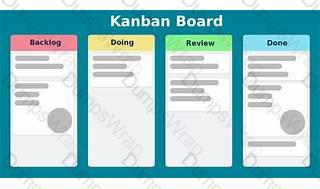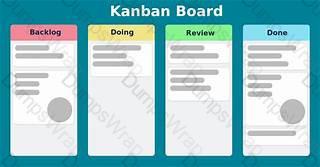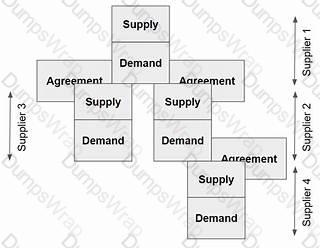Certified in Transformation for Supply Chain (CTSC) Questions and Answers
At what point of its transformation to digital supply chain would a company onboard talent with specific digital skills?
Which of the following actions is considered one of the SCORmark benchmarking steps?
When a company moves their operations closer to home, this is an example of:
Which of the following six sigma improvement phases involves collecting data on current performance and issues?
The external boundary conditions that impact an organization's core strategic vision include market size, customer requirements, legal and regulatory landscape, and:
A company is developing a supply chain strategy that is more focused on creating value. Based on this approach, which of the following steps is the most important for this company to take?
In order to build organizational support to extend the supply chain initiative to the greater value chain, the core team should:
As part of the digital supply chain transformation process, leadership should have its team of stakeholders prioritize which of the following as strategic assets?
ISO 14001 outlines the management system requirements for which of the following areas?
Which of the following infrastructure elements of the supply chain information system have a significant impact on supply chain transformation?
Which of the following collaboration mechanisms involves the establishment of long-term relationships with partners to improve the overall efficiency and effectiveness of the supply chain?
Designing the supply chain to enable the overall business strategy can also mean:
One of the most important steps that leadership can take in developing talent for a digital supply chain transformation process is to:
What operational framework references a pull system that includes visual cards to represent a work item?
Which of the following roles does a change agent involved in supply chain transformation most likely play?
A supply chain manager wants to reduce waste and labor in their manufacturing process and is looking for a visual way to indicate the need for a component that is linked to consumer demand.
Which lean manufacturing tool would be the best option?
Which option best describes an appropriate operational focus for supply chain transformation?
Functional products would be best suited for what type of supply chain?
A retail company is experiencing stockouts of a popular product due to supply chain disruptions.
Which of the following steps should the company take to address this issue according to the theory
of constraints (TOC)?
The most prominent characteristic of a digital supply chain is:
When developing supply chain performance objectives and aligning the performance drivers to the strategic plan, the initial steps in the workflow include:
Effective collaborative relationships with supply chain partners are more likely to be forged when a team buys into which of the following three areas?
A service company is experiencing long wait times for customer service. According to the theory of constraints (TOC), which of the following steps should the company take to address this issue?
What is the frozen time fence in the process of scheduling and managing the execution of activities required to create a product?
The most effective way to communicate the specifics of a planned supply chain transformation includes which of the following activities?
A production line has a total of 8 hours of line time available. If it takes 2 hours to prepare the line to run the product and 5 hours of actual run time, what is the utilization rate?
Which of the following approaches is best for an organization focused on developing a supply chain leadership mindset?
In a gap analysis, one of the most frequently used approaches in measuring operating income is:
The key outputs of analyzing performance within the SCOR framework are:
What is the most important driver to determine a metrics tracking cycle?
Which of the following strategies deals with making a shift from traditional ways of operating to ways that make extensive use of data, technology, and business models in innovative ways?
Which of the following roles is generally defined as a sponsor of an improvement effort?
Which of the following metrics is measured as the value created by reducing or eliminating cost increases sought by supplier over and above prevailing baseline cost?
Which supply chain model can handle high demand during peak season and quickly adjust to a lean period with low demand?
What is the last phase of the transformation project?
Creating a replica of a real process, product, or service in order to create a virtual representation is called a digital:
A company looking to enter the airline industry has determined that the threat of new entrants is low and the bargaining power of suppliers and buyers is high. There is a highly competitive
landscape with numerous substitutions available. What tool has the company used for its industry analysis?
For customized offerings with infrequent demand, which operating model should be chosen?
Why is external benchmarking against similar supply chains recommended in the development of a balanced scorecard?
A widget manufacturing company wants to embark on a digital supply chain transformation journey. Which of the following activities should the company's leadership focus on in the beginning?
Documenting supply chain processes and maintaining updated documentation are used to achieve:
A company undergoing a supply chain transformation is working on developing enhanced metrics to measure digital supply chain performance. Which of the following criteria best illustrates the
evolution of traditional metrics?
Which of the following statements is an example of an external motivator for executing a supply chain transformation?
In new product development, which concurrent engineering technique helps ensure efficient production process to meet customer requirements?
A smartphone manufacturer is able to track the ways people using its devices navigate social media. As a result, the manufacturer has included renaming and regrouping of default social media
apps in its latest major update. From a digital supply chain perspective, this is an example of:

 Kanban
Kanban A screenshot of a board
Description automatically generated
A screenshot of a board
Description automatically generated Supply chain
Supply chain